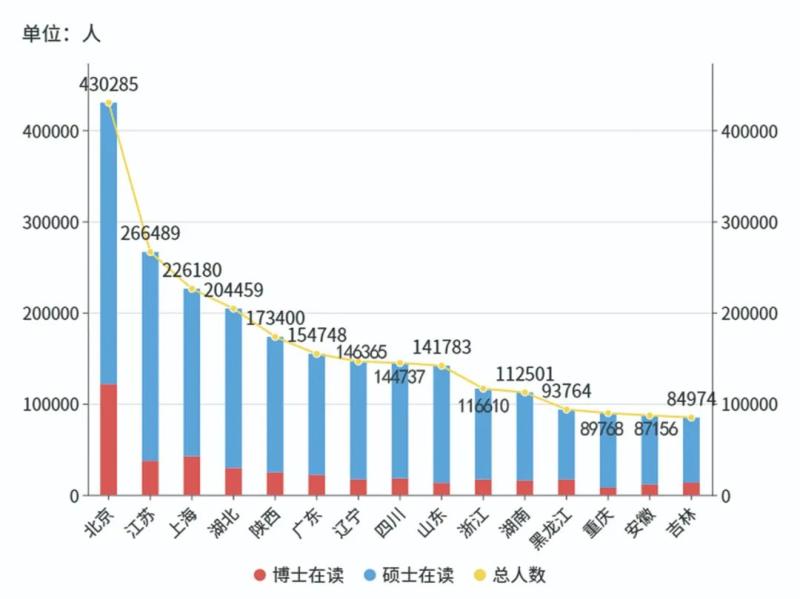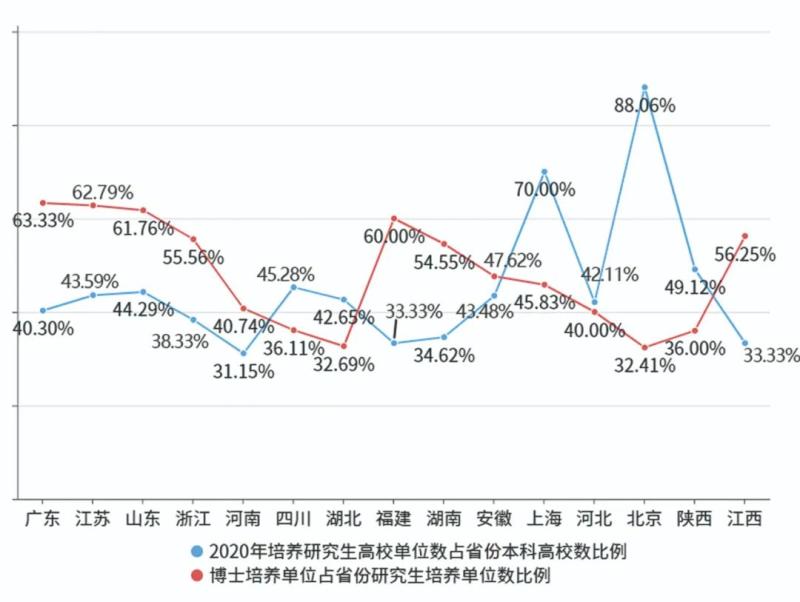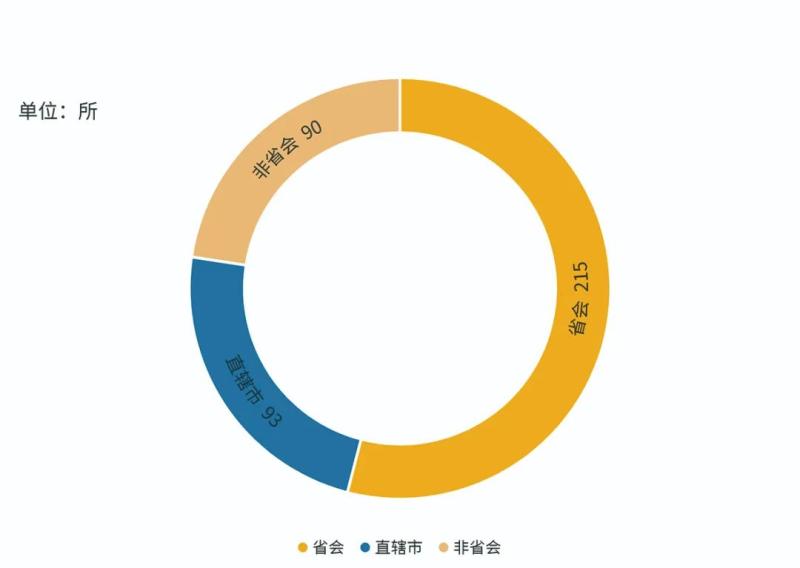Part of the trillion yuan GDP urban doctoral programs are "suspended", with over 500000 doctoral students distributed on the "map": nearly 80% are doctoral students in provincial capitals | universities | GDP
Wen | Ma Xingyu, Zhao Yifan, Hu Yuanyuan, Zhang Ziyue, Dong Yuxin, Zhu Mengjie, Zhang Tian
Not long ago, the news that the number of master's and doctoral graduates in this year's college graduates in Beijing exceeded that of undergraduate students for the first time touched many people's nerves. People suddenly realize that without realizing it, the doctoral student team in our country has grown to such an extent.
In fact, as early as the previous round of degree review and authorization in 2020, 398 universities in China had already obtained doctoral degree authorization qualifications. If military academies and research institutions are added, the number has reached around 452. Obtaining the authorization qualification for doctoral degrees has always been a landmark event for universities to seek promotion and advancement. The possession of doctoral programs has also become an important indicator of the university's educational strength, and is an important basis for obtaining policy and resource support. With the increasing emphasis on talent attraction in various regions, the number of doctoral degree authorized universities has become an important reference for measuring the comprehensive strength of a city or region.
This article will sort out the geographical distribution of universities with doctoral degree authorization, as well as the characteristics of doctoral degree authorization disciplines owned by different universities, in order to provide everyone with an understanding of the current distribution and development trends of doctoral resources.
Over 400 doctoral degree granting units over 40 years
In 1980, the Standing Committee of the National People's Congress approved the Regulations on Academic Degrees of the People's Republic of China. Afterwards, the State Council approved the first batch of 151 doctoral degree granting units. In 1984, 45 new doctoral degree granting units were established. Since 1981, China has conducted 13 batches of degree authorization audits, 1 "Service to National Special Needs Talent Training Project" degree authorization audit, and multiple professional degree authorization audits, and established a dynamic adjustment system for degree authorization points.
Since 2012, through degree authorization review, 115 new doctoral degree granting units have been added to the regular batch in China. After adding 28 authorized doctoral institutions in 2018, 95500 doctoral students were admitted that year, and the number of doctoral students in China reached 389500. In 2021, China's doctoral training institutions expanded once again, with the addition of 34 universities. The number of university training institutions reached 398, and the number of doctoral students enrolled that year reached 509500. In 2022, the number of doctoral admissions reached 139000, while the number of students on campus reached 556100, an increase of 166600 compared to 2018.

Figure Top 15 Provinces in Number of Doctoral and Master Students in 1.2020
As the highest level of talent cultivation in universities, China has adopted a strict and cautious attitude towards doctoral degree authorization units and disciplines. However, in order to cater to certain universities with disciplinary strength, involvement in national special needs fields, and currently without the right to confer graduate degrees, the 28th meeting of the Academic Degrees Committee of the State Council approved the "Opinions on Carrying out Pilot Work of" Serving National Special Needs Talent Training Projects ". In 2012, the first batch of 35 universities obtained project approval and were able to recruit and train master's and doctoral students within a certain period of time and a limited range of disciplines, and award corresponding degrees.
This project has brought development opportunities to universities that currently do not have doctoral degree authorization. For example, Jiangsu Normal University relies on serving the special needs of the national sweet potato industry technology system to recruit doctoral students, while Changzhou University and Nanjing University of Finance and Economics have achieved a magnificent transformation from relying on special projects to adding independent first level discipline authorization points.
In the doctoral program review and evaluation conducted in 2020, six original special program universities represented by Minnan Normal University were converted into officially authorized doctoral program universities. As of now, a total of 16 universities have completed the transformation from special talent programs to doctoral degree authorization units.
Some trillion GDP cities do not have doctoral programs
The number of doctoral programs is an important measure of the comprehensive strength of universities, and their regional layout also reflects to some extent the spatial distribution pattern of high-quality higher education resources in China.
From the perspective of provincial administrative regions, all 31 provinces in China have doctoral training units, and 19 provinces have over 10 universities with doctoral programs. Among them, the top five universities in terms of quantity are Beijing, Jiangsu, Shanghai, Liaoning, and Shandong, all of which have more than 20 doctoral programs. Beijing, with its strong higher education resources, has 47 doctoral universities, ranking first in the country.

Figure 2. The proportion of master's and doctoral training units in the top 15 provinces of GDP
Figure 3. Top 15 provinces with doctoral programs
From a regional perspective, there are a total of 164 doctoral degree authorized universities in the three major regions of Beijing Tianjin Hebei, Yangtze River Delta, and Pearl River Delta, accounting for 40% of the total number of doctoral degree authorized universities. Among the three provinces and one city in the Yangtze River Delta region, there are 74 universities with doctoral programs, including 27 in Jiangsu Province, 22 in Shanghai, 15 in Zhejiang Province, and 10 in Anhui Province. There are a total of 71 doctoral universities in the Beijing Tianjin Hebei region, including 47 in Beijing. There are 19 universities in Guangdong Province that have doctoral degree authorization qualifications.
There are a total of 23 doctoral authorized universities in Sichuan Province and Chongqing City within the Sichuan Chongqing Economic Circle. It is worth mentioning that as a traditional old industrial base, the "Three Eastern Provinces" have 48 doctoral universities, accounting for 12% of the total number in the country.
It is not difficult to see that the regional distribution of doctoral programs shows a significant imbalance, and there are significant regional differences.
From a city perspective, the four municipalities directly under the central government have a total of 93 doctoral degree authorized universities. Among them, Beijing occupies half of the country.
In addition, more than half of the doctoral universities are distributed in 27 provincial capital cities, with a total of 215 universities, accounting for 77.39% of the total number of authorized doctoral universities in China, along with the number owned by 4 municipalities directly under the central government.

Among the provincial capital cities, Nanjing, Xi'an, Wuhan, Guangzhou, and Harbin are among the top five universities with doctoral programs. Among them, there are 17 in Nanjing and Xi'an respectively, with 16, 14, and 13 in the last three cities, followed closely by Shenyang, Hangzhou, and Chengdu.
There are a total of 90 doctoral universities in non provincial capital cities, with 70 universities in prefecture level cities and below, except for cities specifically designated in the plan. Dalian and Qingdao, cities specifically designated in the plan, have a prominent number of doctoral universities, with 8 and 7 respectively. Despite their lower economic output compared to Shenzhen and Ningbo, they have achieved a reversal in higher education resources due to their profound historical heritage.
Among prefecture level cities, Guilin ranks first with four doctoral universities, followed closely by Xuzhou with three.
At present, 24 cities, including Beijing, have settled in the "trillion yuan club" of gross domestic product. 225 universities in these cities have doctoral degree authorization points, accounting for more than half of all doctoral degree granting universities. Among them, 178 universities in 10 cities, including Beijing, Shanghai, and Guangzhou, have doctoral programs, and their respective number of universities exceeds 10, indicating a high concentration of high-quality higher education resources.
It is worth noting that although Foshan and Dongguan are also members of the "trillion dollar club", no university has a doctoral program so far.
Figure 4. Number of doctoral universities owned by municipalities directly under the central government, provincial capital cities, and non provincial capital cities respectively
The most doctoral programs in normal universities

At present, 76 universities directly under the Ministry of Education in China have doctoral training qualifications, and among other universities directly under central ministries and commissions, 24 universities have doctoral training qualifications. The remaining 298 universities with doctoral degree authorization are all local universities. Obviously, the proportion of doctoral programs in universities directly under central ministries and commissions is much higher than that of local universities. However, various policy measures from provincial and ministerial co construction to provincial co construction of universities reflect the continuous strengthening of national support for local universities.
From the perspective of university names, only 28 colleges have doctoral programs, mostly in the fields of music, sports, aesthetics, and medicine; A total of 38 normal universities have doctoral degree authorizations, with the highest number among all types of universities, followed closely by science and technology universities and science and technology universities, with 28 and 26 respectively; There are also over 20 medical and agricultural universities.
Figure 5. Departmental affiliation of universities authorized by doctoral programs
In the two rounds of newly added doctoral degree authorization units in 2017 and 2020, a total of 86 doctoral programs were approved for addition or need to be strengthened, involving 55 different disciplines and 11 different disciplines.
Among them, "science, industry, agriculture, and medicine" are quite popular. Among the first level disciplines, applied economics has added up to 6, chemical engineering and technology, and traditional Chinese medicine have all added 5, clinical medicine has added 4, and food science and engineering, civil engineering, materials science and engineering, and biology have all added 3, closely following. The increase in doctoral programs in literature and history is relatively small, with only Chongqing Normal University being approved to add new doctoral programs in archaeology and Minnan Normal University adding new doctoral programs in Chinese language and literature.
The approval results of doctoral degree programs not only reflect the urgent demand of the country for professionals in science, engineering, agriculture, and medicine, but also indirectly reveal the solid foundation and continuous improvement of education in the field of cultural, historical, and philosophical education in the country.
Figure 6. Cloud map of university terms with doctoral programs

annotation
① Unless otherwise specified in the text, the training units only include universities and do not include military academies and research institutions, such as the National University of Defense Technology; At the same time, the relevant research institutes in different campuses and their related branches, such as Shenzhen and Suzhou, are not included.
② According to the list of higher education institutions released by the Ministry of Education, North China Electric Power University is not included separately, and all three universities in the field of geology, mining and oil are calculated separately.
③ Due to incomplete information on the number of graduate training units in each province in 2021 and 2022, data from 2020 was used in Figure 2 of the article.
④ The doctoral program universities mentioned in the article include the School of International Relations, which was rated as an additional doctoral granting unit in the 2020 authorization approval and needs to be strengthened. However, the school was not found in the Notice on the Progress Verification Results of the Construction of New Doctoral and Master's Degree Granting Units that Need to be Strengthened.
China Science Daily




